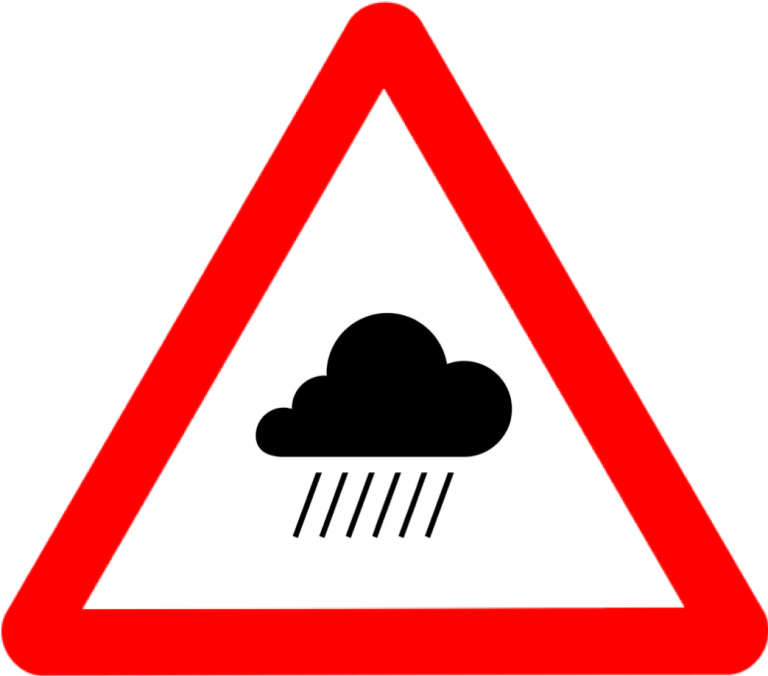Aviation - Hazards - Precipitation

Rainfall
While there is no agreed international definition regarding rainfall intensity, some use the following criteria: Heavy rain is defined as rates in excess of 4 mm per hour while heavy showers are defined as rates in excess of 10 mm per hour. Showers are further classified as being violent if the rate exceeds 50 mm per hour, although these are normally considered to be rates typical for tropical regions.
Terms such as ‘very heavy’ have no official definition, but they and terms like them will be used below to describe rainfall rates much greater than normally expected, and would be associated with thunderstorm activity. For aviation purposes, rain rates are essentially a measure of rain water content.
Heavy or very heavy rates of rainfall will clearly have a detrimental impact upon general visibility. However, in addition to any true meteorological reduction of visibility, raindrops impacting the windscreen/canopy will additionally reduce visibility. Windscreen wipers (if fitted) may not be able to fully cope with the rainfall rate.
Light, non-pressurised aircraft may find the heaviest rain rates allow water ingestion into the cabin/cockpit/engine compartments with subsequent risks to electronic equipment.
Civil airliner engines are tested and certified to ensure that engines will normally not ‘flame out’ under conditions of intense rainfall and water ingestion. Tropical cyclones, however, are a different issue.
Runway flooding or areas of deep standing water will affect braking action and may result in asymmetric braking and possible sliding off runways.
Low cloud (stratus pannus) may form in periods of moderate or heavy rain, when it had not previously been expected.
Note that heavy rain may occur without the presence of a Cumulonimbus cloud. On such occasions, the cause will be thick, deep layers of frontal cloud, perhaps enhanced by orographic forcing. Nimbostratus ought to be reported (and indeed forecast) if such rainfall is expected to fall from non-convective clouds. There is no fundamental reason why Cumulonimbus clouds may not be embedded within Nimbostratus.
Snowfall
Snow is solid precipitation in the form of individual, usually branched, ice crystals or an agglomeration of those ice crystals. The precise nature will depend upon the temperature and conditions in which they develop. At temperatures warmer than about 5° C the crystals tend to agglomerate. Even slight rates of snowfall have a serious detrimental effect upon visibility.
Non-melting snowflakes at sub-zero temperatures will be largely deflected in the airstream and not adversely affect the majority of the airframe. However, where snow is deflected into engine nacelles or into cavities such as open wheel wells, the snow may collect and ‘pack’ to create obstructions. Such obstructions may restrict airflow into engines, or prevent retraction of landing gear.
On the ground, whilst stationary or taxiing, snowfall may accumulate on the airframe, disturbing the aerodynamics and adding to the all up weight of the aircraft. Windscreens may become obscured with snow, with windscreen wipers becoming ineffective (if fitted).
Pitot tubes may become blocked, with resultant errors in airspeed and altitude indication.
Wet (melting) snow may not be so easily deflected by airflow, and may more readily ‘pack’ against blunt surfaces of the airframe. As noted above, when snow packs into and against engine nacelles, wheel wells, or engine intake grilles, significant consequences may result.
Runway contamination by snow will significantly degrade braking action. Snow accumulations will also obscure runway lights and possibly make it difficult to discern the runway from the adjacent grass areas, especially given that visibility will also be degraded.
There are occasions when precipitation is as rain at the surface of the aerodrome, but may be as snow at approximately 1000 ft above. Under these circumstances aircraft ‘in the circuit’ or on approach will be affected by snow.
Snow must be removed completely from an aircraft prior to take-off, usually through the application of a de-icing fluid. It is a fatal error to assume that snow on the aircraft will be removed by aerodynamic forces during start-up, taxiing and take-off.
CLICK HERE to return to our homepage
